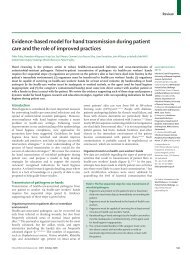The Developmental Neuropsychology Lab - Diana L. Robins
The Developmental Neuropsychology Lab - Diana L. Robins
The Developmental Neuropsychology Lab - Diana L. Robins
You also want an ePaper? Increase the reach of your titles
YUMPU automatically turns print PDFs into web optimized ePapers that Google loves.
<strong>The</strong> <strong>Developmental</strong><br />
<strong>Neuropsychology</strong> <strong>Lab</strong><br />
<strong>Diana</strong> L. <strong>Robins</strong>, Ph.D.<br />
Georgia State University<br />
drobins@gsu.edu<br />
http://www2.gsu.edu/~psydlr
Autism-related research in the<br />
<strong>Developmental</strong> <strong>Neuropsychology</strong><br />
<strong>Lab</strong> at GSU<br />
o Toddlers at risk for ASD (M-CHAT)<br />
o Emotion perception in ASD
Modified Checklist for Autism<br />
in Toddlers (M-CHAT)<br />
o Filled out by parent during child’s regularly<br />
scheduled pediatrician visit<br />
o 23 parent report, yes/no items, administered at 16-<br />
30mos (5mins)<br />
o Screen positive: fail any 3 items, OR fail 2 critical<br />
items, OR flagged by the pediatrician<br />
www.mchatscreen.com
M-CHAT<br />
o Each positive screen is followed by the M-CHAT<br />
Follow-up Interview<br />
o Contains specific probes for each item for which<br />
the child scored at-risk<br />
o If child continues to screen positive after the<br />
interview, full developmental and diagnostic<br />
evaluation<br />
www.mchatscreen.com
No follow<br />
(N=7999)<br />
Not at Risk<br />
Metro-Atlanta primary care<br />
sample (N=8770)<br />
Not at<br />
Risk<br />
AT RISK<br />
Phone Interview (N=771)<br />
AT RISK<br />
No eval.<br />
(N=473)<br />
Declined/<br />
Excluded<br />
(N=155)<br />
Qualify for an<br />
Evaluation (N=80)<br />
Non-ASD<br />
(N=25)<br />
Declined<br />
(N=23)<br />
ASD<br />
(N=32)
Summary of M-CHAT Research<br />
o Total published sample = 10,847 low-risk toddlers,<br />
across studies<br />
o plus high-risk toddlers, examined separately<br />
o 6-10% of children required follow-up interview<br />
o 50 children diagnosed with ASD (1 in 217); this is<br />
50-65% of children who showed ASD risk on M-<br />
CHAT + Follow-up Interview<br />
Kleinman et al., 2008; Pandey et al., 2008; <strong>Robins</strong>, 2008
Current M-CHAT Research<br />
o Ongoing collection of cross validation sample,<br />
emphasis on diverse sample (race/ethnicity, SES)<br />
o Re-screening entire sample at age 4 to ascertain<br />
misses and calculate absolute sensitivity and<br />
specificity<br />
o Multi-stage screening to maximize sensitivity and<br />
specificity/positive predictive value
Current M-CHAT Research<br />
o Collaborating with Lauren Adamson to examine<br />
developmental trajectories in toddlers who screen<br />
positive on the M-CHAT<br />
o Studying the influence of factors such as<br />
race/ethnicity, maternal education, SES on<br />
screening success (investigators: Wimsatt, Zaj,<br />
Hazzard, <strong>Robins</strong>)
Emotion perception in ASD<br />
o fMRI & DTI to examine the network of brain regions<br />
involved in emotion perception in ASD and typicallydeveloping<br />
individuals (<strong>Robins</strong> & King)<br />
o Psychophysiological measures of emotion perception,<br />
including facial electromyography, skin conductance,<br />
and heart rate (Rozga, Mumaw, King, & <strong>Robins</strong>)<br />
o Behavioral correlates of emotion perception (e.g.,<br />
adaptive functioning: Banks, <strong>Robins</strong>, & King; eye<br />
tracking: McManus & <strong>Robins</strong>)
Dynamic Multimodal Affective<br />
Stimuli<br />
ANGRY?<br />
QuickTime and a<br />
TIFF (Uncompressed) decompressor<br />
are needed to see this picture.<br />
TASK:<br />
Press one button<br />
for YES, the other<br />
button for NO
Preliminary fMRI findings<br />
Controls<br />
(n=5)<br />
Fusiform<br />
MFG/IFS<br />
ASD<br />
(n=8)<br />
Fusiform<br />
y=-55 y=23<br />
MFG/IFS<br />
Angular gyrus<br />
Compensatory<br />
mechanism?<br />
y=-55<br />
y=23<br />
y=-61
Facial Electromyography<br />
Frown activates corrugator<br />
QuickTime and a<br />
TIFF (LZW) decompressor<br />
are needed to see this picture.<br />
Smile activates zygomatic
Preliminary EMG Findings<br />
25<br />
Happy Stimuli<br />
20<br />
% change over baseline<br />
15<br />
10<br />
5<br />
0<br />
-5<br />
Corrugator<br />
Zygomatic<br />
TD group shows increases in<br />
zygomatic activity in response to<br />
happy and increases in corrugator<br />
activity in response to angry<br />
TD<br />
ASD<br />
% change over baseline<br />
8<br />
7<br />
6<br />
5<br />
4<br />
3<br />
2<br />
1<br />
0<br />
Corrugator<br />
Angry Stimuli<br />
Zygomatic<br />
TD<br />
ASD
Preliminary EMG Findings<br />
% change over baseline<br />
25<br />
20<br />
15<br />
10<br />
5<br />
0<br />
-5<br />
Corrugator<br />
Happy Stimuli<br />
Zygomatic<br />
TD group shows increases in<br />
zygomatic activity in response to<br />
happy and increases in corrugator<br />
activity in response to angry<br />
TD<br />
ASD<br />
% change over baseline<br />
ASD group shows increases in<br />
zygomatic activity in response to<br />
happy and angry stimuli<br />
8<br />
7<br />
6<br />
5<br />
4<br />
3<br />
2<br />
1<br />
0<br />
Corrugator<br />
Angry Stimuli<br />
Zygomatic<br />
TD<br />
ASD
Acknowledgments<br />
Current postdocs, grad students<br />
and postbacs:<br />
• Sharlet Anderson<br />
• Margaret Banks<br />
• Julia Juechter<br />
• Meena Khowaja<br />
• Susan McManus<br />
• Kimberly Oliver<br />
• Vivian Piazza<br />
• Agata Rozga<br />
• Noelle Santorelli<br />
• Jamie Zaj<br />
Current Undergraduate RAs: Rebecca Bosch, April Coignard, Lora Henderson, Mirjana<br />
Ivanisevic, Amy Lasher, Molly Locklear, Robert Rivera, Janice Taylor, Sheniece Willis,<br />
Amber Wimsatt, Shelly Zody<br />
Funding sources: NICHD: 2R01HD 035612, 2R01HD 039961; Autism Speaks; Center for<br />
Behavioral Neuroscience, NSF Agreement # IBN-9876754;<br />
GSU-CDC Seed Grant; Brains<br />
& Behavior Initiative at GSU; GSU Faculty Mentoring Grant<br />
Collaborators: Tricia King, Lauren Adamson, Roger Bakeman, Ann Hazzard (Emory),<br />
Deborah Fein (UConn) & her team, Bob Schultz (Yale/CHOP), Wendy Stone (Vanderbilt)
















